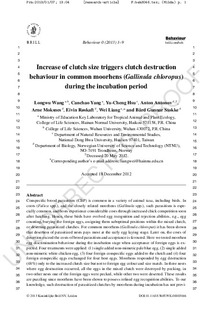| dc.description.abstract | Conspecific brood parasitism (CBP) is common in a variety of animal taxa, including birds. In coots (Fulica spp.), and the closely related moorhens (Gallinula spp.), such parasitism is especially common, and hosts experience considerable costs through increased chick competition soon after hatching. Hence, these birds have evolved egg recognition and rejection abilities, e.g., egg counting, burying the foreign eggs, assigning them suboptimal positions within the mixed clutch, or deserting parasitized clutches. For common moorhens (Gallinula chloropus) it has been shown that desertion of parasitized nests pays most at the early egg laying stage. Later on, the costs of desertion exceed the costs of brood parasitism and acceptance is favoured. Here we tested moorhen egg discrimination behaviour during the incubation stage when acceptance of foreign eggs is expected. Four treatments were applied: (1) single added non-mimetic pale blue egg, (2) single added non-mimetic white chicken egg, (3) four foreign conspecific eggs added to the clutch and (4) four foreign conspecific eggs exchanged for four host eggs. Moorhens responded by egg destruction (47%) only to the increased clutch size but not to foreign egg colour and size match. In three nests where egg destruction occurred, all the eggs in the mixed clutch were destroyed by pecking, in two other nests one of the foreign eggs were pecked, while two other nests were deserted. These results are puzzling since moorhens have been shown to possess refined egg recognition abilities. To our knowledge, such destruction of parasitized clutches by moorhens during incubation has not previously been reported. We suggest that after clutch completion, moorhens use increase in clutch size as a cue to determine if they have been parasitized, and some individuals choose to reject parasitic eggs by deserting or destroying the whole clutch. | nb_NO |
